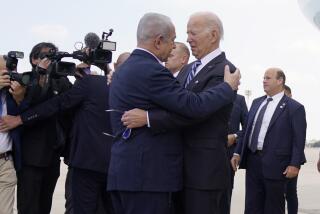Bush Stalls on Nuclear Arms
- Share via
The recent charge by the Soviet foreign minister that President Bush has been slow and timid in negotiating cuts in strategic nuclear arms has surely been brought up this week with Secretary of State James A. Baker III. Indeed, the Bush Administration has failed to complete a treaty that former President Ronald Reagan nearly finished a year ago.
Baker struck a positive note this week by lifting demands for a ban on mobile missiles. But Bush’s reluctance apparently goes deeper than technical points in the negotiations, and will be difficult to overcome.
The Strategic Arms Reduction Talks (START) aim to reduce the superpowers’ 25,000 intercontinental nuclear weapons. The formula on the table would reduce each arsenal to 6,000 weapons on 1,600 ballistic missiles and bombers. The Soviet Union would cut 50% of its missile warheads; the United States, 37%. The formula for cutting the number of bombs and cruise missiles is such that the overall reductions would be about 30% for the United States and 40% for the Soviets.
Bush’s reticence seems to be focused on four concerns:
Mikhail S. Gorbachev’s longevity. U.S. officials reportedly believe that the sweeping reform of Soviet life will fail and that a more conservative and hostile regime will replace Gorbachev’s, possibly leading to new superpower tensions.
The concern is doubly misplaced. First, Gorbachev’s political position seems secure, with allies in all important posts. Second, even if the gloomier scenario is correct, now is the time to disarm the Soviet bear.
This worry about Gorbachev should be turned on its head: We can accelerate liberal reform in the Soviet Union (and Eastern Europe) by signing START, giving Gorbachev a key political victory.
Conventional cuts first . The U.S. nuclear arsenal was initially meant to deter the Soviets from attacking Western Europe with conventional forces. New and promising negotiations are under way to cut such forces. Some in Washington believe those talks should be concluded before a START treaty can be seriously undertaken.
The two can go forward simultaneously. And if START--which is less complex--is finished first, the United States and NATO face no danger of Soviet aggression. It is unthinkable that Gorbachev would thus sacrifice all that he has achieved. Moreover, the post-START nuclear umbrella remains intact.
Peace through strength . Some analysts insist that only large, diverse and superior nuclear forces guarantee U.S. security. In fact, however, the Soviet nuclear arsenal expanded by nearly 30% from 1981 to 1986, an intense period of superpower hostility. Moscow was not cowed by U.S. bluster; it responded with more arms building.
The peace-through-strength outlook also mistakes the changes Gorbachev has wrought in Soviet defense. The end of hegemony in Eastern Europe, the unilateral disarmament measures, the new military glasnost, the economic need for peace and commitment to “defense sufficiency” clearly signal a revolution in Moscow’s thinking that renders peace-through-strength counterproductive in approaching arms cuts.
“Star Wars.” Reagan’s attachment to Strategic Defense Initiative seems to have carried over to Bush, although the new Administration has modified earlier claims of its effectiveness. Though the technical and strategic merits of SDI have scarcely improved, Bush has committed to five years of funding at $33 billion, with deployment of a space-based defense--however inept--shortly thereafter.
The Soviets continue to be sensibly chary of SDI. The best way to defeat missile defense is with more offense; thus, Moscow will not sign a deep-cuts accord without guarantees that the 1972 Anti-Ballistic Missile (ABM) Treaty limiting missile defenses is kept intact.
There is no greater symbol--and no greater hazard--of the Cold War than the immense nuclear arsenals each nation maintains. Bush has gracefully proclaimed the end of the Cold War and a new post-containment era ahead. Now it’s time to act.
More to Read
Sign up for Essential California
The most important California stories and recommendations in your inbox every morning.
You may occasionally receive promotional content from the Los Angeles Times.













